- HOME
- Top Page
- Our Businesses
- Non-Destructive Inspection
Non-Destructive Inspection
As a "doctor" of buildings and plants, we use the quality assurance technology that we have cultivated to provide accurate inspection data. We will contribute to the realization of a stock-type society by making full use of our unique special technologies, such as general non-destructive inspections, piping scale checkers, extreme value analysis of heat exchange tubes, water immersion UT, and super blast.
- Surface scratch inspection
- Magnetic particle inspection - Penetrant inspection - Eddy current flaw detection inspection - Visual inspection
- Internal flaw inspection
- Radiation transmission inspection (CR) - Ultrasonic flaw detection inspection (phased array) - Ultrasonic wall thickness measurement (wall thickness evaluation) - Water immersion UT inspection (IRIS)
- Special inspections
- Heat exchange tube extubation inspection (extreme value analysis system) - Scale checker (diagnosis of clogging in piping) - Handheld live video X-ray image system (Open Vision) - AC magnetic inspection (MDK) - Fluorescent X-ray analysis (material discrimination) - Eddy current array inspection (ECA)
- Other- X-ray CT inspection
- CCD camera survey - SDM visual inspection work - Quality control work - Baking soda cleaning system - Circulation cleaning system - Annealing work
X-Ray CT Inspections (Microfocus)
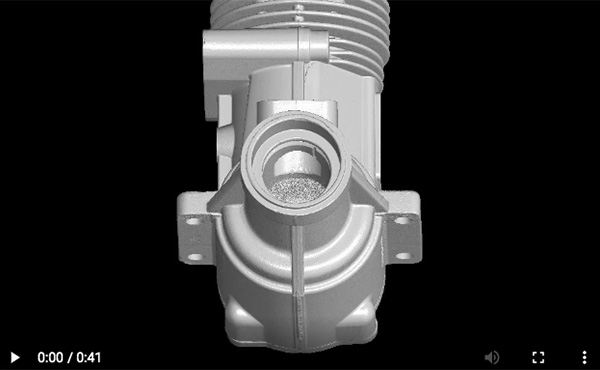
-
With microfocus X-ray CT equipment, the latest non-destructive inspection technology, we conduct three-dimensional measurement on a wide range of materials such as castings, aluminum die castings, batteries, CFRP, ceramics, and skeleton specimens.
[Uses]
- Internal defect detection, dimensional measurements, analysis
- Research and design support
- Defective product inspection
- Geometric shape comparison, reverse engineering
[Application examples]
- Auto parts: Castings, aluminum die castings, etc.
- Aerospace equipment: Batteries, honeycomb materials, CFRP materials, etc.
- Electronic components: Electronic boards, semiconductors, cable terminals, etc.
- Other: Ceramics, wood, rocks, organisms, skeleton specimens, etc.
Click here for more information about contract services for X-ray CT equipment scanning.
Handheld Live Video X-ray Image System (Open VisionCF)
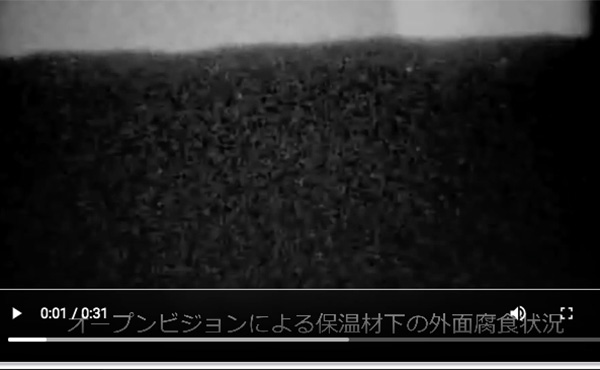
-
This battery-powered portable live video X-ray system is a state-of-the-art non-destructive inspection device designed for field work.It makes it possible to check for corrosion under heat insulating material, check for leakage in piping, etc. in real time with video and still images.
[Application examples]
- CUI (Corrosion inspection under heat insulating material)
- Checking the welding position of heat insulating material piping
- Checking for leaks contained in heat insulating material piping
- Checking the inside of resin, rubber products, etc.
- Checking the inside of packages, etc.
Click here for more information about the Handheld Live Video X-ray Image System.
Radiation Transmission Inspection (CR System)
-
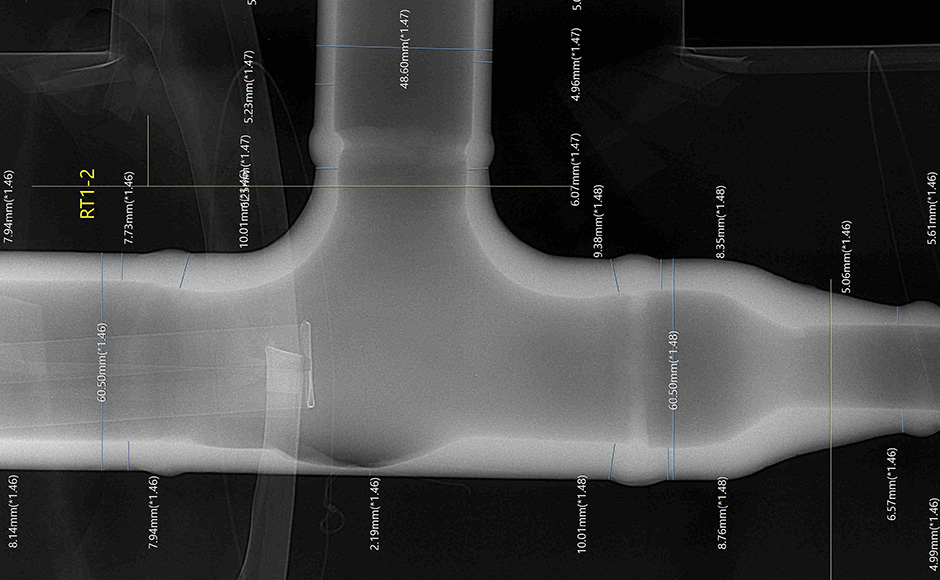
-
Radiation inspection, which is a typical non-destructive inspection technology, uses a computed radiography system (CR) that uses an imaging plate (IP) instead of X-ray film to provide high-definition, high-quality, fully digital X-ray fluoroscopic images.
[Imaging examples]
- Equipment such as plant facilities - Pipe thinning and cracking surveys
- Imaging evaluation of objects with large wall thickness differences, such as valves
- Reinforcing bar arrangement survey of concrete structures
- Product inspection of precision parts such as electronic devices
- Endurance diagnosis of trees, etc.
- Checking the inside of ruins and relics
Ultrasonic Flaw Detection Test (Phased Array Ultrasonic Flaw Detection)Ultrasonic Flaw Detection Test (Phased Array Ultrasonic Flaw Detection)
-
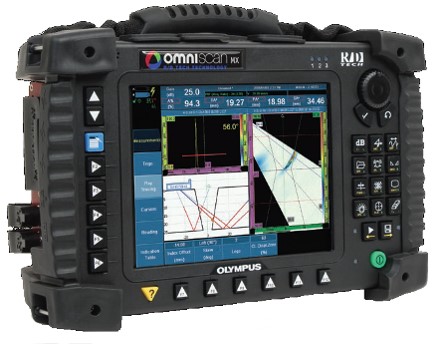
-
We use ultrasonic flaw detectors equipped with advanced non-destructive inspection technology to provide high-precision flaw detection results. This technology adds a cross-section visualization function to the conventional ultrasonic flaw detection function.
[Detection examples]
- Hydrogen-induced cracking sector, linear scan
- Stress corrosion cracking detection
- Inspection of cracks inside bolts
- Surface flaw detection image analysis of tank bottom plates, etc.
- Investigation of internal defects in thick plate welds
- Hydrogen erosion inspection
- Deterioration survey of FRP tanks
- Thinning survey of buried areas of anchor bolts
Heat Exchange Tube Sampling Inspections
In order to maintain the reliability of the equipment and ensure safe operation with the heat exchanger, we conduct an extubation inspection of the heat exchanger tube. This system combines a wall thickness measurement system and an extreme value analysis system to estimate the remaining life of the entire heat exchanger tube from the measurement results.
- Compact design that does not require restrictions on the measurement location
- Outer-shape measurement
- Collective management of inner and outer surface minimum wall thickness measurement results
- Easy operation
- Manual measurement method
- Immediate printout from measurement to analysis by PC processing
Baking Soda Cleaning Work
Compared to the metal surface peeling work, which commonly uses the sandblasting method and ultra-high pressure cleaning with water, there is no concern that blast cleaning using baking soda (sodium bicarbonate = NaHCO3), which has a much lower pressure, will damage surfaces. This has allowed us to overcome various challenges in our work.
[Detection examples]
- Internal base treatment of heat exchange tube for IRIS inspection, etc.
- Scale removal on the outer surface of the boiler tube
- Cleaning of glass lining surfaces
- Cleaning of thin plates such as for plate heat exchange
- Cleaning of mild steel such as the outer surface of the air fin cooler
- Cleaning of the outer surface of turbine blades, etc.
* The stuck scale is dissolved by circulating a scale removing agent (ECO acid) in the heat exchange tube for a certain period of time. Combined with super blast, it also removes scale that is firmly stuck inside the tube, which was difficult in the past.
Checking the Inside of a Column (Measurement of Radiation Transmission Dose)
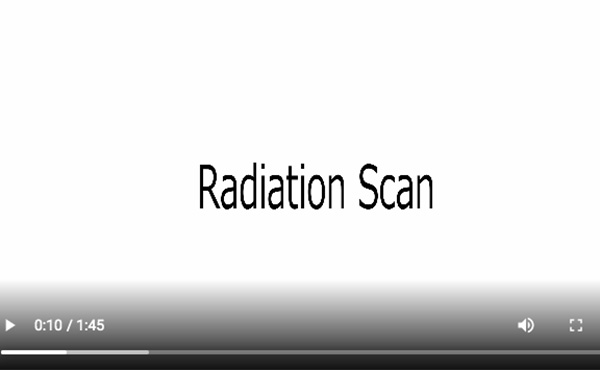
-
Checking the internal conditions of the equipment that makes up an oil refining plant / chemical plant during operation is useful for grasping abnormalities in the equipment. It is also useful for planning maintenance (cleaning / repair), and understanding appropriate operating conditions to improve efficiency.
"Radiation scan," our proprietary special non-destructive inspection technology, estimates the inside of the equipment from the amount of radiation attenuation during operation and the internal structure, and then we use the measurement chart to create drawings. For an example, please see the scan results for the plate column that is used commonly for distillation. Anomalies are found by scanning the liquid levels on the tray and of the downcomer. In addition, "radiation scan" can be used to check the level, scale deposits, and adhesion of the content inside the equipment.
AC Magnetic Particle Inspection (MDK: Magnetic Detector Kaisei)
A special non-destructive technology MDK sensor is a device which the AC magnetic flux generated by the coil passes through the test specimen and returns to the sensor. Therefore, there is no magnetic flux attenuation as seen in the eddy current test method, making it possible to reveal information inside and outside the body.
[Inspection examples]
- Checking for cracks inside and outside the test specimen
- Metal structure change due to metal fatigue
- Checking for wall thinning under the heat insulating material
- Checking the metal quenching status
- Checking for non-uniform phase such as plating peeling
- Checking the inside of the flexible pipe
Water Immersion UT Inspection (IRIS Inspection)
Water Immersion UT Inspection (IRIS Inspection)
Features of water immersion UT (IRIS) inspection, which is our proprietary non-destructive inspection technology
- In addition to visual scanning, image analysis is also possible (for the inner surface side)
- Real-time (chart output) + image analysis is possible
- Flaw detection data can be imported to the hard disk
- All flaw detection data can be imported
- Compared to conventional machines, flaw detection speed is significantly improved (30 mm / sec)
- Detection is possible up to0.6 mmt for auto operation, and up to0.3 mmt for manual operation
- The complete series of work is possible, from the collection of data to the preparation of reports.
Pipe Clogging Diagnosis (Scale Checker)
Understanding pipe clogging, scale buildup, red rust, and the current state of plant equipment is essential for failure prediction, maintenance planning, and improved operational conditions. Scale checker, a special non-destructive inspection device developed by our company, uses a trace radioactive isotopes (not regulated by law) to measure and visualize foreign matter that has adhered to piping.
- Measurement is possible even from above cold insulation material
- Measurement is possible even if there is a fluid such as water
- Display of scale adhesion on PC on site
- Measurement of piping of up to 400 mmφ (main unit also available for sale)
Eddy Current Array Inspection
The eddy current array, which is a special non-destructive inspection technology, uses multiple coils (number of coils: 32, coil diameter 3 mm) so that high detectability can be maintained over the entire probe length for the defect range to be inspected.
The inspection results are displayed and recorded in easy-to-understand colors.
[Advantages of eddy current array inspection]
- A wide range of inspections can be performed in a short time by imaging
- Since it is an eddy current inspection, no pretreatment equivalent to PT inspection is required
- Inspection from the top of the paint is possible depending on the conditions
- Alternative inspection for PT inspection in tanks in which chemicals are prohibited (food, etc.)
- Relative evaluation of defect depth from palette color is also possible based on the test sample
- High-speed inspection of complex structural parts is possible
- Screening inspection for tissue deterioration is possible
